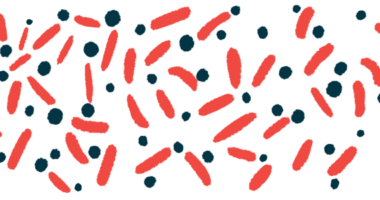Blocking PD-1 Protein Activation May Result in Better Bacteria Killing
High levels of protein linked to lung disease, infection in children

In children with cystic fibrosis (CF), elevated levels of programmed death protein 1 (PD-1) in cells called macrophages are linked with lung disease, inflammation and infection, a study reports.
Blocking PD-1 activation resulted in more efficient killing of Pseudomonas aeruginosa, the most common bacteria found in CF patients.
Such findings suggest that “modulation of PD-1 signaling may be of interest in airway diseases,” according to the researchers.
“Here, we showed preliminary evidence that PD-1 blockade … improved bacterial clearance,” the team wrote.
The study, “Macrophage PD-1 associates with neutrophilia and reduced bacterial killing in early cystic fibrosis airway disease,” was published in the Journal of Cystic Fibrosis.
Investigating PD-1 activation
Macrophages are key immune cells in the airways, because they are quick responders to lung infection and injury. PD-1 is a protein found at the surface of immune cells, with key functions in regulating T-cells in cancer and vital infections.
However, the role of PD-1 in macrophages — a type of white blood cell that surrounds and kills bacteria and other microorganisms — is less known. Studies suggest that PD-1 modulates macrophage function.
Neutrophils are another immune cell type. In CF, neutrophils recruited to the airways undergo reprogramming, which means a switch between an anti-inflammatory and a pro-inflammatory type.
Here, an international team of researchers investigated the levels of PD-1 in macrophages in children with CF. To do so, they analyzed samples of both blood and bronchoalveolar lavage fluid (BALF) — a fluid used to rinse the lungs, commonly used to study immune cells, infectious agents, or other molecules present in the airways.
These samples came from 45 children with CF — 22 boys and 23 girls — ages 3 to 62 months, or about 5 years.
Almost all of the children (40 of 45) carried the F508del mutation, the most common cause of CF, in at least one CFTR gene copy.
Most also had pancreatic insufficiency, a common condition in CF in which the pancreas is unable to release digestive enzymes to break down food in the intestine. The children were not being medicated with CFTR modulators at the time of sample collection.
The study’s results showed that levels of PD-1 were significantly higher in airway macrophages when compared with other immune cells. Specifically, they were increased 10 times versus those in neutrophils and 17 times higher than in T-cells.
Higher levels of the binding molecules PD-L1 and PD-L2 in macrophages and T-cells suggested activation of PD-1 signaling. The researchers noted, however, that differences to neutrophils may be partially explained by other measurements.
The team then assessed whether PD-1 signaling correlated with parameters of early lung disease. While no significant link was seen between PD-L1 or PD-L2 levels and clinical outcomes, data from 24 CF children showed that higher PD-1 on airway macrophages correlated significantly with higher (worse) scores for structural lung damage and infiltration of the airways by neutrophils.
A significant correlation also was seen for bronchiectasis — a condition in which the airways are damaged, usually as a result of inflammation, becoming thickened and damaged over time.
“These findings suggest a potential link between neutrophilic inflammation, airway macrophage PD-1 expression, and early structural lung damage in CF,” the scientists wrote.
Increased levels of PD-1 in airway macrophages were not influenced by sex, genetic profile, or the ability to use lipids (fats).
Notably, the main factors linked with high PD-1 were age, neutrophil-released molecules, and the presence of at least one of several organisms in collected BALF. These were Pseudomonas aeruginosa, commonly called P. aeruginosa, Staphylococcus aureus, Haemophilus influenzae (all bacterial species), and Aspergillus fungi.
The next task was to untangle the contribution of each predictor to PD-1 levels in CF airway macrophages.
Results showed that even in the absence of a detectable infection, neutrophil-mediated inflammation correlated significantly with high PD-1 in macrophages. Such inflammation was shown by the release of neutrophil elastase and interleukin-8.
In fact, in vitro (lab) studies with monocytes, from which macrophages derive, showed that exposure to CF neutrophils-released factors was enough to trigger the increased expression of PD-1 in these cells.
To determine whether PD-1 on airway immune cells influences cell behavior, the researchers tested the outcomes of a PD-1-blocking antibody. They also tested a chemical called SHP099 that inhibits PD-1 signaling upon exposure of CF macrophages to P. aeruginosa, considered the key bacterial agent in CF lung disease.
This experiment was conducted using BALF samples, and showed that blocking PD-1 signaling results in improved bacterial killing.
Finally, the researchers showed that PD-1 signaling was not dependent on CFTR protein function.
Given that “PD-1 is known to play a key role in controlling macrophage responsiveness in several conditions, modulation of PD-1 signaling may be of interest in airway diseases other than CF which also feature chronic bacterial infections,” the study concluded.








